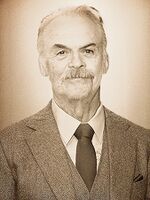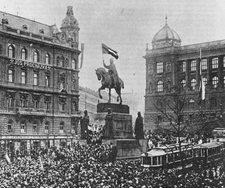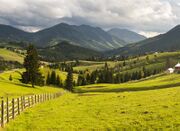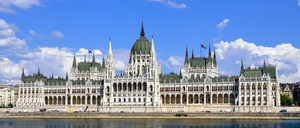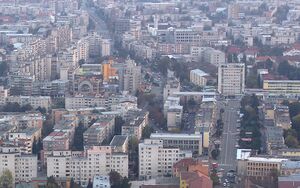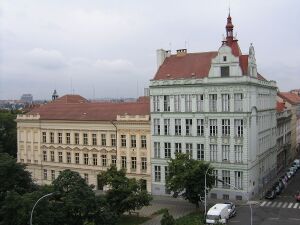Ostrozava
This article is incomplete because it is pending further input from participants, or it is a work-in-progress by one author. Please comment on this article's talk page to share your input, comments and questions. Note: To contribute to this article, you may need to seek help from the author(s) of this page. |
Prime Republic of Ostrozava Ostrozavská Primárská Republika | |
|---|---|
Motto: "Dělníci se spojují, aby se dařilo!" "Workers, come together to thrive!" | |
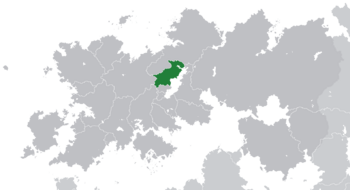 Ostrozava's Location in Belisaria | |
 Political Map of Ostrozava | |
| Capital and largest city | Karsko |
| Official languages | Ostrozavan |
| Recognised regional languages | Gariman, Tolyk |
| Ethnic groups (2009) | Ostrozavan (80.6%) Gariman (6.1%) Tolyk (4.6%) Velik (4.2%) Ludz (3%) Other (1.5%) |
| Religion |
|
| Demonym(s) | Ostrozavan |
| Government | Federal socialist two-party premier-presidential constitutional republic |
• Primar | Dominik Moravec |
• Facilitator | Vincenc Dostál |
• Supreme Justice | Alan Michálek |
| Legislature | People's Congress |
| Area | |
• Total | 256,160 km2 (98,900 sq mi) |
| Population | |
• Estimate | 37,204,940 |
• Census | 2009 |
| GDP (nominal) | 2018 estimate |
• Total | 1,076,896,988,300 |
• Per capita | 28,945.98 |
| Gini (2018) | 36.9 medium |
| HDI (2018) | 0.729 high |
| Currency | Haler (Ͱ) (OZH) |
| Time zone | Belisarian Central Time (+1) |
| Date format | DD/MM/YYYY |
| Driving side | right |
| Calling code | +14 |
| Internet TLD | .oz |
Ostrozava, officially the Prime Republic of Ostrozava (Ostrozavan: Ostrozavská Primárská Republika), is a country in central Belisaria. It is bordered to its west by XX, with which it shares warm relations, to the south by Garima and Verbiza, and to its east by Velikograd. It also shares maritime borders with Drevstran and Milostia. The Prime Republic has a landlocked and hilly landscape that covers an area of 256,160 square kilometers (98,904 sq mi), largely situated in the Northern Belisarian Plain, with its borders with XX marked by the medium-height Czelia Mountains. A large part of the nation borders Lake Kupalnitsa, with a mostly temperate continental climate and oceanic climate. It is a federal presidential republic anchored in socialism, with 37.2 million inhabitants. Its capital and largest city is Karsko, with 2.1 million residents; other major cities are Libebor, Jirkov, Táborov, and Orlorec.
Ostrozava is a developed country with an advanced, high income social market economy. Ostrozava is often considered to operate in the political paragdim between a socialist state and a traditional presidential democracy. It is a federal republic and a representative democracy anchored in worker's rights and socialistic principles, although it does not consider itself a socialist state officially; one of the two major politically active parties in Ostrozava is the Socialist Party. It is a welfare state with a Socialist model, universal health care, and tuition-free university education. It ranks as the ninth safest and most peaceful country, though it performs lukewarmly in democratic governance.
The territory of modern Ostrozava was inhabited by the West Gothic people from the 2nd millennium BCE until Slavic colonization in the 3rd century. From the 9th century onward, it was occupied by West Slavic peoples which primarily consolidated in the Grand Duchy of Ostrozava. In 1909, the Crimson Revolution overthrew the Grand Duchy and established the current Prime Republic of Ostrozava. As a fragile newcomer to the Belisarian political stage, in 1921 Ostrozava attempted to strengthen its political system, introducing Bauerist elements gleaned from its socialist neighbor of [XX]], which established the two-party paradigm and current constitutional status quo. Since 2008, the state has been governed by the Progressive Party. Ostrozava is a member of the Forum of Nations, through which it is the headquarters of the Intercontinental Telecommunications Union, and it is one of the most integrated members of the Angrast Accord.
Culturally, Ostrozava is considered part of both central and eastern Belisaria. Though primarily a West Slavic country, the nation has sizeable minorities of related groups, including Garimans, Veliks, and Ludz, as well as some immigrants from Tsurushima and Jhengtsang. The official language of the country is Ostrozavan, a language related nominally to Seredinian and Velik dialects; Gariman is a recognized regional language in the subprime state of Kolava (Gariman: Ustengard).
History
Prehistory
Archaeologists have found evidence of prehistoric human settlements in the area, dating back to the Paleolithic era. Skulls found in the Great Cave of Vornja are some of the oldest human remains found in Belisaria, and have served as a prominent example of neolithic human culture, ritual, religion, and jewelry. Early civilizations in modern Ostrozava seem to have been of primarily Germanic origin; in addition to a wide variety of proto-Germanic tribes in modern Kolava, the primary civilization of the majority of modern Ostrozava were the western Goths, which primarily coalesced around the city of Saragetra in modern Livalina. The height of the Gothic kingdom in Ostrozava came around 700-500 BCE; Gothic chieftain Ariemir's burial site is considered to be one of the prime examples of Germanic religious tradition in eastern Belisaria.
Grand Duchy
Spurred by Velikoslavian invasion in the late 900s CE, Ostrozava experienced a profound demographic shift at the dawn of the middle ages, with the modern Ostrozavan identity slowly being created in the modern-day north of the country. The south of modern Ostrozava was dominated from 1124 onward by the Tolyk-majority Kingdom of Livalia. In 1142, spurred by an increased Christianziation of eastern Belisaria, differing Duchies in northern Ostrozava, including the Dutchy of Karsko, were united by the first Grand Duke of Ostrozava, Norbert of Kubik, which was born of a Gothic mother and a Slavic father; Norbert's mixed identity lent him credibility among the ethnically and religiously mixed populace of Ostrozava, allowing him to consolidate power despite his alleged tendency towards anger and illiteracy.
Throughout the middle ages, the Grand Duchy expanded and took over neighboring states, assimilating the Duchies of Velikoslavia and Ustengrav in the Ostrozavan Wars of Expansion, which lasted from 1242 - 1302, coinciding with the transferral of power within the Duchy from the founding Kubik dynasty into the fully Ostrozavan Beran dynasty, which had adopted Orthodox Christianity despite a growing majority of Fabrians inside the nation. In 1344, the Grand Duchy conquered the Kingdom of Livalia, with Grand Duke Vlastislav taking the title for his own while continuing to style himself as a Grand Duke for reasons of legacy and tradition. At their maximum extent in 1420, the borders of Ostrozava included the entirety of the modern country, several Gariman territories, Polnitsa, and Velikoslavia. Though a growing hub of commerce and intellectual and technological development, the Ostrozavan state lagged behind the rest of the world due to religious tensions, which coincided with the greater Fabrian Reformation, leading to the Ostrozavan Collapse in 1590, which allowed resurgent states like Garima and Nachtmark to the south to seize control of outlying territories, while Velikoslavia declared its independence due to its strong Orthodox traditon.
In 1612, the Vykopal dynasty seized control of most of modern Ostrozava, and, as a Fabrian Catholic, the dynasty now was congruent with the beliefs of the majority of the populace. While a brutal system of serfdom was instituted by the dynasty as a carryover from feudalism in an age of growing merchantilism, the new Grand Duchy used a variety of methods to control and expand its domestic power, including religious manipulation, forced Ostrozavization, and instiutionalized alcoholism. The growing Socialist philosophy resulted in a brief takeover of the city of Karsko in 1840 by a Socialist-aligned militia headed by disgraced former General Marek Klimeš. Though the rebellion was smashed and control of the capital returned to the Grand Duke in late 1842, the event would serve to galvanize both domestic and international Worker's movements, and led to a steady increase of resentment towards the Grand Duchy which would extend into the 20th century.
Revolution and Prime Republic
In 1901, Ostrozavan popular movements, particularly the leftmost progressives and middle-class craftsmen living in cities, took note of other revolutionary movements brewing throughout Belisaria, including the successful Christmas Revolution and resultant civil war in Seredinia. The ruling Vykopal dynasty of the Grand Duchy had maintained a steady hold on power since <<prior event>>, mainly by increasing pseudo-democratic reforms which established a lackluster infrastructure of popular representation, especially at the village level. Amid peasant strikes in 1905, the Grand Duchy of Ostrozava formally abolished serfdom, being one of the last states in Belisaria to commit to the policy. The partially-industrialized countryside could not handle the shock of the economic reform, and Ostrozava was one of the contributing factors to the Belisarian economic recession of 1908, which also affected XX and later contributed to the XX Revolution.
In late 1908, the 1st Ostrozavan Worker's Convention was called, unifiying the disparate worker's movements in the Grand Duchy in a common goal of seeking worker's reform. Inspired primarily by Tsurushiman ideologies and growing leftist thought in Mont, the main two political blocs which unified were the Prime Socialist Party, which aimed for a worker's republic and were ostensibly allied with the XX Socialist Party, and the Democratic Party, which aimed for the abolishment of the weakened monarchy in Ostrozava in favor of a democratic republic with free political thought, in the footsteps of the Seredinian movement. Though ideologically split on whether the vision for Ostrozava would require full state socialism, the two parties agreed that stark economic and administrative reform were needed in Ostrozava. The Grand Duchy, wary of the possibility that the Ostrozavan military would defect to the cause of the workers and cause a protracted civil war as had happened in Seredinia, attempted to adopt a stance of openness and neutrality towards the Worker's Convention.
On 21 March 1909, the Worker's Convention submitted their demands to the Grand Duke, including the first draft of the Ostrozavan Social Contract as written by Vladan Vítek, leader of the Democracy Party. Grand Duke Borek I Vykopal denied the Worker's Convention's demands, and, gambling for the military's loyalty, ordered the arrest and execution of the Worker's Convention leadership. The orders shook the Ostrozavan military, with Grand General Albert Kraus claiming that the act had no legal basis. Despite the protest, the Ostrozavan military also refused to ally with the Worker's Convention, hoping instead to maintain the status quo. Amid military inaction and the prospect of a new future, mass protests and rioting began across Ostrozava in the Summer of 1909, with many minor nobles facing deportation and imprisonment; in October 1909, after the Grand Duke ordered the execution of Kraus for treason, the military formally declared its tentative allegience to the Worker's Convention, and on 14 November 1909, the Grand Duke was formally deposed by protestors with rioting support in what came to be known as the Crimson Revolution. The Grand Duke and his family were executed by firing squad in the 1910 Karsko Trial; on 1 July 1910, the first draft of the Ostrozavan Social Contract was ratified and the Prime Republic of Ostrozava formally created, with Oto Sládek being elected as the first Primar, of the Democratic Party. The nascent Prime Republic quickly saught friendship with the Seredinian Federation.
In 1921, with the XX Revolution in XX having formally established the first official socialist state in the world, and worker's movements in the infant Congress feeling sidelined by Democratic interests, the 2nd Ostrozavan Worker's Convention was called, which saught to amend the Ostrozavan Social Contract. With Democratic leadership wishing to keep the most extreme and violent elements of revolutionary socialism out of Ostrozava, the second Worker's Congress saught up a full rewrite of the second half of the Social Contract, maintaining assurances of free speech and free expression while also assuring protected worker's rights and adding Bauerist-socialist language. This was seen as a successful compromise between pro-democratic and pro-socialist factions in the Convention, and led to the current version of the Social Contract. Though not intended by the members of the Worker's Convention, the revised Social Contract established a two-party status quo between the Socialist Party and Democratic Party. In 1930, the Socialist Party took power and began building relations with XX while also maintaining Ostrozava's independent geopolitical identity.
Reform and Integration
Rapid industrialization initiatives, including the Modernity Decade program begun in 1942, helped modernize Ostrozava, though it still lagged behind the world economy. In this time, many Subprime governments engaged in cultural engineering projects meant to better intstil "balanced leftist thought" in the nation's younger populace. This included the banning of the idealization of religion and "extreme capitalism" in media and educational curriculum. Already absent from political mention after the Crimson Revolution, religion was abolished from the educational curriculum in 1945, after the landmark Hájková v. Church of Prokop Supreme Court case.
In 1952, the Democratic Party was reformed in to the social democratic Progressive Party. The economy continued to stagnate behind more developed nations in the west and far-east throughout the middle of the 20th century and split control of the People's Congress hampering legislative development in favor of partisan bickering and fears of a 3rd Worker's Convention. In 1965, comprimise candidate and Progressive Oskar Beránek became Primar. Beránek was considered one of the leftmost progressives in his party, and instituted many successful policies, including a single-payer healthcare insurance system and the creation of the New Society program, which created standardized public areas and apartment buildings throughout Ostrozavan urban areas, similar to those seen in XX. As with other mass urbanization movements, New Society's urban planning often included the demolishing of old and historic buildings, which drew harsh criticism from the broader international community, especially religious authorities.
Despite international criticism, many of these mid-century reforms helped to develop a new, secular Ostrozavan identity which cemented the ideologies in the Ostrozavan Social Contract and helped to raise morale in a time of economic uncertainty. After a temporary industrial boom under Socialist control in the late 1960s and early 1970s which included the creation of Delia Automotive, Ostrozava entered into a hard economic recession in the mid-1970s, as its industrial might began to stagnate with increasing industrialization and the opening up of cheaper manufacturing markets in the far east. In 1985, Ostrozava's first and currently only Primara, Progressive Eva Sedláková, instituted broad economic reforms inspired by the technocratic government of Tsurushima, which included mass liberalization of business laws and redenomination of the Ostrozavan haler while maintaining regulations on crony capitalism. Despite protest from far-left elements in the People's Congress, Sedláková's economic reforms were successful and are considered to have laid the groundwork for modern Ostrozava; by 1995, Ostrozava's economy had recovered, with only key industries maintaining full government control. In 1990, Ostrozava elected by referendum to become a member of the Forum of Nations, ushering in what is considered to be an era of growing international integration, despite the Prime Republic's continued neutrality. This trend continued with Ostrozava's ratification of the Angrast Accord later that decade.
Geography
The Ostrozavan landscape is varied. Kolava, to the west, is host to the Czelia mountains, a low mountain range on the border with XX. Its highest peak is Oglav, at 1,511 m (4,957 ft). Litonín, in the central part of the country, is also quite hilly. Ostrozava has two main waterways, both flowing eastward into Lake Kupalnitsa. The first and largest river is the Karmin river, which flows through Karsko. The nation's second largest waterway, the southeastern-flowing Balrog River, merges into the Karmin in Znomo.
Phytogeographically, the vast majority of Ostrozava is located inside the Central Belisarian Plain. According to the IBEST Conservational Fund, the territory of the Prime Republic can be subdivided into four ecoregions: the Central Belisarian broadleaf forests, Lake Kupalnitsa grove forests, Velikogradian mixed forests, and Czelian montane conifer forests.
Ostrozava has one of the largest areas of undisturbed forest in Belisaria, covering almost 30% of the territory; recent lumber drives have significantly cut back this number. Some 4,200 plant species have been identified in the country, from which to date 15 have been declared natural monuments, 26 missing, 123 endangered, 340 vulnerable, and 2,150 rare.
Temperate forest in northern Litonín.
Government and politics
The Prime Republic is a unique form of federation, officially describing itself as a "People's Federation", or "Worker's Federation" (Ostrozavan: Dělnická federace). It is a representative democracy, "in which majority rule is tempered by minority rights protected by law". The government is regulated by a system of checks and balances defined by the Ostrozavan Social Contract, which serves as the country's supreme legal document and constitution. For 2018, the P.R.O. ranked 39th on the Democracy Index and 12th on the Corruption Index. In the Ostrozavan socialist-federalist system, citizens are all unilaterally subject to three levels of government: Prime, Subprime, and Local. The local government's duties are typically split between city governments and county governments, with the former holding jurisdiction over urban areas while the latter hold jurisdiction over rural and suburban areas. In almost all cases, executive and legislative officials are elected by a plurality vote of citizens by district; representation at all levels is typically first-past-the-post in nature, though some areas have local variation or proportional representation.
The Prime government comprises three branches:
Legislative: The unicameral People's Congress, headed by the Facilitator, makes federal law, declares war, approves treaties, has the power of the purse, and has the power of impeachment, by which it can remove sitting members of the government. It also has the ability to amend and change the Social Contract. The Primar selects the Facilitator, but only the People's Congress may approve the selection. The cabinet is selected by the Facilitator.
Executive: The Primar acts as the head of state, chief diplomat, and head of Foreign Affairs. As Ostrozava is a semi-presidential system, the Primar names but cannot dismiss the Facilitator. The Primar also holds the power of dismissing the People's Congress, calling a Worker's Congress, naming but not approving various executive officials, and exercise a one-time suspensive veto. The Facilitator has control over internal executive matters, serving as a parliamentary head of government who administer and enforces Prime laws and policies; all of the Primar and Facilitator's decisions are subject to Congressional override.
Judicial: The Supreme Court and lower Prime courts, whose judges are appointed by the People's Congress, interpret laws and overturn those they find unconstitutional; they are considered to have the final say on all matters relating to the Social Contract. They collectively hold jurisdiction over the Ostrozavan Defense Force, though the Prime Commander is self-selected.
The People's Congress has 350 voting members, each representing a congressional district for a two-year term. Congressional seats are apportioned among the subprime voting districts by population every twenty years. The Subprime governments are structured in a roughly similar fashion as the Prime, though the Social Contract allows them leeway in organization. The executive of each state is directly elected, with most consisting of committees instead of individual positions. Most state judges and cabinet officers are appointed by the governors of the respective states, while others are elected by popular vote; many municipal governments, especially those traditionally belonging to the Socialist Party, have organized themselves as Worker Collectives or organized unions.
Law
Ostrozava is a federation with a civil law system based on the continental type, rooted in Bauerist and Tsurushiman legal culture; Ostrozavan law is considered a distinct subset of Belisarian law. The basis of the legal system is the 1985 Legal Amendment to the Ostrozavan Social Contract. The court system includes municipal, subprime and prime courts and is divided into civil, criminal, and administrative branches. The Supreme Court consists of 15 constitutional judges and oversees violations of the Constitution by either the legislature or by the government. It also has jurisdiction over many political matters, such as the formation and closure of political parties, jurisdictional boundaries between government entities, and the eligibility of persons to stand for public office. As the Supreme Court has full jurisdiction over constitutional interpretation, and as such they are considered to have jurisdiction over the Ostrozavan military, which is itself semi-autonomous.
Federal subjects
Internally, the Ostrozavan state is divided into seven constituent republics, established in 1928, and one autonomous area consisting of the federal capital of Karsko. In alphabetical order, these subprime constituencies are:
| Name | Capital | Flag | Coat of Arms | Location |
|---|---|---|---|---|
| Autonomous City of Karsko | Karsko | |||
| Subprime Republic of Litonín | Libebor | |||
| Subprime Republic of Vamo | Táborov | |||
| Subprime Worker's Republic of Kolava | Jirkov | |||
| Subprime Republic of Orlošín | Orlorec | |||
| Subprime Republic of Znomo | Hodobem | |||
| Subprime Republic of Livalina | Balta | |||
| Subprime Socialist Collective of Strakosko | Buděrec |
Foreign relations
Traditionally, Ostrozava has avoided formal alliances that might entail military, political, or direct economic action and has been officially neutral since the creation of the Prime Republic; the Ostrozavan Social Contract outlines a general policy of non-interventionism, though the nation has bent this rule many times in the past. Only in 1990 did Ostrozava become a full member of the Forum of Nations; it was the first state to join it by referendum. In 1995, Karsko became the headquarters of the newly-created Intercontinental Telecommunications Union, a then-controversial move, given the recency of Ostrozava's admission to the organization.
Owing to its ideologically mixed base, Ostrozava has maintained solid diplomatic relations with both socialist and non-Socialist nations since its reconstitution. Socialist or socialist-adjacent nations with close relations to Ostrozava include its western neighbor of XX, with which it shares ethnic and ideological history, and Tsurushima, with which Ostrozava has a special trade partnership. Non-socialist nations of close relation primarily include Belisarian democracies occupying similar ideological space, particularly Seredinia. Though not formally opposed to the Belisarian Community or the prospect of Belisarian monarchy, Ostrozavan foreign policy has been cool to the bloc since its creation. Ostrozava has recently expressed interest in expanding relations with the international socialist community, though it has shied away from endorsing totalitarian states such as Jhengtsang. Ostrozava's neutral stance and position between socialist and non-socialist spheres has led to the nation serving as a diplomatic intermediary between other nations in the past.
In 2002, Ostrozava was the first nation to join the Angrast Accord after its initial creation, thus generating its first regional commitment in more than a century; Ostrozavan interests have recently been bent in support of Angrast nations more than those not in the accord, however, the formally stated objectives of the Ministry of Foreign Affairs still outline a policy of neutrality.
Military
The Ostrozavan Defense Force consists of the Ostrozavan Land Forces, the Ostrozavan Air Force, the Ostrozavan Navy, and of specialized support units. The armed forces are managed by the Department of Home Defense. The Prime Commander is the commander-in-chief of the armed forces; he is elected by all active service members every five years. In 2004 the army transformed itself into a fully professional organization and compulsory military service was abolished. Defense spending is approximately 1.19% of the GDP. The Defense Force is charged with protecting the Prime Republic and its allies; since their reconstitution in 1982, they have generally operated with non-interventionist goals.
Economy
In 2018, Ostrozava had a nominal GDP of around $1.08 billion and a GDP per capita of $28,945. According to the Mercantile Society of Sor, Ostrozava is a high income country with an evolving mixed economy. According to the Belisarian Institute of Economics, Ostrozava's GDP per capita was at 64% of the Belisarian average in 2018, an increase from 41% in 2007, making Ostrozava one of the fastest growing economies on the continent.
After 1980 the country experienced a decade of economic instability and decline, led in part by an obsolete industrial base and a lack of structural reform. From 1995 onward, however, the Ostrozavan economy was transformed into one of relative macroeconomic stability, characterized by high growth, low unemployment and declining inflation. According to The World Bank, the GDP per capita purchasing power parity grew from $13,442 in 1990 to an estimated $20,124 in 2010. However, Ostrozava still has one of the lowest net average monthly wages on the continent and an inflation rate of −1.1% as of 2018. Unemployment in Ostrozava was at 8.3% in August 2018, which is fairly high for Belisarian countries.

In 2018, 35.1% of Ostrozavans were employed by state-controlled companies, 55.5% were employed by private companies, and 10.4% were employed by foreign companies, particulary of Seredinian origin. The country relies on its neighbors for various imports, primarily energy imports such as petroleum and natural gas. Important agricultural products include dairy and meat products. The largest local companies include car maker Delia Automotive, Kadlec Electrical, Nováček Telecom, and the Belisarian Worker's Bank. Exports have increased substantially in the past few years, with a 18% annual rise in exports in 2010. Ostrozava's main exports are cars, software, clothing and textiles, industrial machinery, electrical and electronic equipment, metallurgic products, raw materials, pharmaceuticals, fine chemicals, and heavy machinery (especially trains and tramways). Trade is mostly centered on Belisaria, and more particularly Mont, with Tsurushima and Pulau Keramat consisting of the most important intercontinental trade partners.
The currency of Ostrozava is the Ostrozavan Haler (Ͱ), which was redominated as a result of inflation in the mid-1980s. Therefore, on 1 January 1985, amid broader economic reforms, 10,000 old Ostrohaler (OZO) became one new Haler (OZͰ). Since then, the currency has been relatively stable, with an exchange rate fluctuating between 3 and 4 Haler for one Schilling.
Demographics
According to the 2010 census, Ostrozava's population is 37,204,940. Like other countries in the region, its population is expected to stabilize in the coming years as a result of sub-replacement fertility rates and a neutral net migration rate. In October 2010, Ostrozavans made up 80.6% of the population. The largest ethnic minorities are the Garimans, 6.1% of the population, the Tolyks, with 4.6% of the population, and the Velik, with 4.0% of the population. Garimans constitute a near-majority in the Subprime Worker's Republic of Kolava, with Litonín also holding a sizable minority. Tolyks constitute a majority in about half of the counties in the Subprime Republic of Livalina. Other minorities include the Ludz, Zvečajians, Koscians, Siverians, and Tsurushimans. In 1930, there were 745,421 Siverians in Ostrozava, but only about 72,000 remain today. As of 2009, there were also approximately 434,200 immigrants living in Ostrozava, primarily from Tsurushima and Jhengtsang.
Languages
The official language is Ostrozavan, a West Slavic language, which presents a consistent degree of similarity to Ludz and Velik dialects, but equally shares many features with Kosican. Ostrozavan is spoken as a first language by approximately 90% of the entire population, while Gariman and Velik are spoken by 6.2% and 1.2% of the population, respectively. Tolyk has remained the primary language of its respective minority, roughly 4% of the population. There are also approximately 50,000 native speakers of Siverian and 32,000 native speakers of Zvečajian living in Ostrozava.
According to the Social Contract, subprime councils ensure linguistic rights to all minorities, with localities with ethnic minorities of over 20%, that minority's language can be used in the public administration, justice system, and education. Foreign citizens and stateless persons that live in Ostrozava have access to justice and education in their own language. Gariman, Velik, and Anglic are the main foreign languages taught in schools. According to the 2010 census, Gariman is spoken by 35% of Ostrozavans, while Velik is spoken by 21%.
Religion
Partly as a result of leftist ideological initiatives enacted during the 20th century, Ostrozava is one of the most irreligious nations in the world and the most irreligious nation in Belisaria, with 42.2% of the population declaring themselves as having "No Religion", and 33.8% of the population remaining unaffiliated or undeclared spiritually. The Ostrozavan people have been historically characterized as tolerant and even indifferent towards religion. According to the 2010 census, 13.9% of the Ostrozavan population belong to the Fabrian Catholic church, 9.2% to the Orthodox Christian church, and 0.9% followed other forms of religion both denominational or not (of which 1,063 people answered they are Pagan). Before secularization, Ostrozava's population was split between denominations; many in Ostrozava see growing irreligion as a method of avoiding religious and ethnic conflict.
Education
Education in the Prime Republic is compulsory for 10 years and citizens have access to a tuition-free university education, while the average number of years of education is 13.1; there is a high cultural merit placed on attaining high levels of schooling, leading to a generally higher rate of education especially among the middle class. Additionally, Ostrozava has a relatively equal educational system in comparison with other countries in Belisaraia. Founded in 1458, the University of Litonín was the second university in Central Belisaria. Other major universities in the country are Panek University, Ostrozavan Worker's University, Karsko University, and the Ostrozavan Academy of Humanities. The International Bureau of Education, Science, and Traditions, coordinated by the Forum of Nations, currently ranks the Ostrozavan education system as the 15th most successful in the world, higher than the FoN average.
Healthcare
Healthcare in Ostrozava is similar in quality to other Belisarian nations on a social model. The Ostrozavan universal health care system is based on a compulsory insurance model, with fee-for-service care funded by mandatory employment-related insurance plans; until 1985, Ostrozava operated on a single-payer system before all healthcare was fully nationalized. According to the 2016 WOHD Report, the Ostrozavan healthcare is 18th, ranked behind Latium and two positions ahead of Belfras. The most common causes of death are cardiovascular diseases and cancer. Ostrozava has been increasingly affected by a mental health epidemic since the mid-90s; rates of depression have skyrocketed. As a result, Ostrozava is now considered to have one of the best mental healthcare systems in the world.
Culture
Art
The lands which came to constitute Ostrozava have contained important milestones and pieces of prehistoric and pre-Slavic art, including the art of Gothic tribes which inhabited the area of modern Kolava. Chief among ancient Ostrozavan art is the Gothic chieftain Ariemir's burial site, which contains important examples of ancient Gothic fashion, architecture, and sculpture, dating back to roughly 635 BCE.
More contemporary Ostrozavan art, dating back from Slavic times, primarily include religious art, including the famous church murals of northern Znomo. Famous artists that lived during the Renaissance era in the Grand Duchy of Ostrozava or neighboring lands which would later constitute it include Boris Matoušek, Andrea Váňová, and sculptor Dominik Pavlík. Later artists living during the waning years of the Grand Duchy contributed to international movements of post-impressionism, chief among them were brothers Filip and Jan Zacpal. With the Crimson Revolution in 1909, Ostrozava entered into a new era of popular art with socialist influences. Though drawing from socialist and democratic revolutionary iconography worldwide, Ostozavan revolutionary art is notable for incorporating elements of abstract art, including cubism and post-modernism. Today, Ostrozava has continued its rich artistic tradition with several incentivised programs for modern artists; popular contemporary Ostrozavan artists include Linda Švecová and Oliver Vlach.
Architecture
A wide variety of architectural styles can be seen in Ostrozava, owing to its long history and proximity to many differing cultures. Ostrozavan architectural styles are considered to be a fusion of eastern and central Belisarian styles, with some religious influence from the Orthodox and Fabrian legacies, as well as substantial brutalist influence from socialist movements and urban redevelopment programs, particularly the New Society program of the 1960s and 70s. Many medieval castles, particuarly in Romanesque style and Gothic style, dot northern and central Ostrozava, dating back from the time of Velikoslavia. Most famous among these castles is the Gothic Kadlec Castle, which is also one of Ostrozava's most visited tourist sites and most recognizable castles in the world.
Ostrozavan revolutionary architecture is considered predominantly modernist, with later developments including brutalist and functionalist elements. Though considered controversial and even ugly in the eyes of many international vistiors and architectural critics, Ostrozavan brutalist and panel-based buildings have a certain allure within the Ostrozavan cultural conceptions, with many gaining a sense of nostalgia and identity from said architectural developments. Many artists have also played with the contrast between new and old architectural styles, creating the Society Fusion movement of the late 1990s.
Kadlec Castle in Orlošín is a prime example of Ostrozavan Renaissance architecture.
- Marseille - Cité Radieuse (16234847979).jpg
The Kupalnitsa Lighthouse is a prime example of Ostrozavan revolutionary art.
The New Centre of Karsko is considered to be the epicenter of functionalist New Society urban redevelopment.
Media
Ostrozava has a number of major media outlets, chief among which are the national public television channels. PTV (Ostrozavan: Prvotřídní Televize) is Ostrozava's public broadcasting corporation; about a third of its income comes from a broadcast receiver licence, while the rest is made through revenue from political sponsorships and commericials. State television operates two mainstream channels, PTV 1 and PTV 2, as well as regional programs for each of the country's 7 subprime states (as PTV 3). In addition to these general channels, PTV runs a number of genre-specific programmes such as PTV Sport, PTV Dějiny, PTV Kultura, PTV Seriály, PTV Liothidisch, and PTV Ostrozava, the latter is a state-run channel dedicated to the transmission of Ostrozavan language television for the Ostrozavan diaspora abroad. Additionally, Ostrozava has several commercially run 24-hour news channels, many considered to be ideologically based infotainment channels: Bohunec News, Karsko News Network, Sobice Info, and TV Socialistická.
Ostrozavan media also includes nationally syndicated newspapers like První Zpravodajská Ppráva ("Prime News Report"), Karsko Časy ("The Karsko Times") and Ostrozavanský Lidový Zpravodaj ("Ostrozavan Worker's Bulletin") which provide traditional opinion and news, and tabloids such as Lopatka and Šepot. První Zpravodajská Ppráva, founded in 1911, is one of the oldest newspapers still in operation in the country. Premium entertainment channels and streaming services include both international and domestic options; the most popular service for Ostrozavan local media is Filmforma.
Cinema
Ostrozava was one of the first Belisarian nations to adopt the growing medium of Cinema at the turn of the 20th century; during the Crimson Revolution, filmmakers such as Demec Karacev pioneered the genre of Ostrozavan Montage, which sought to illustrate the daily life of an average working person; the genre is considered an important touchstone in the developing genre of the documentary. After the revolution, films were made depicting a wide variety of subjects, including early forays into cinematic science fiction in the genres of Ostrozavan Optimism and Ostrozavan Techno-Film; both of which reached their high water mark in the late 1930s with Belisaria's first hit movie filmed in full Vetricolor, The Alley, made by controversial auteur and Socialist critic Josef Charvát.
With growing regulations on the arts in the 1940s with an increased authoritarian-socialist grip on the government, films reverted to realism and propaganda before a resurgence during the Progressive leadership of the 1960s in the Ostrozavan New Wave, which involved the release of several controversial and briefly-banned films such as the pro-democratic Girl with Paper and the crime thriller Horned Wasp.
With increasing liberalization and opening of the social sphere in the 1980s, auteurs such as Joren Kalishvek and Mihai Muracec launched Ostrozavan cinema into the international eye yet again, with a notable example being The Red Count's Mansion by influential filmmaker-turned-revolutionary Albin Volf, released in 1996. Cinema and filmmaking continues to be a viable industry in Ostrozava, with imposed quotas limiting the number of foreign films, particularly blockbusters, being shown domestically, thus allowing the national film industry to flourish. Ideological controls have waxed and waned in recent years, however, no outstanding laws limiting free expression continue to exist in modern Ostrozava.


